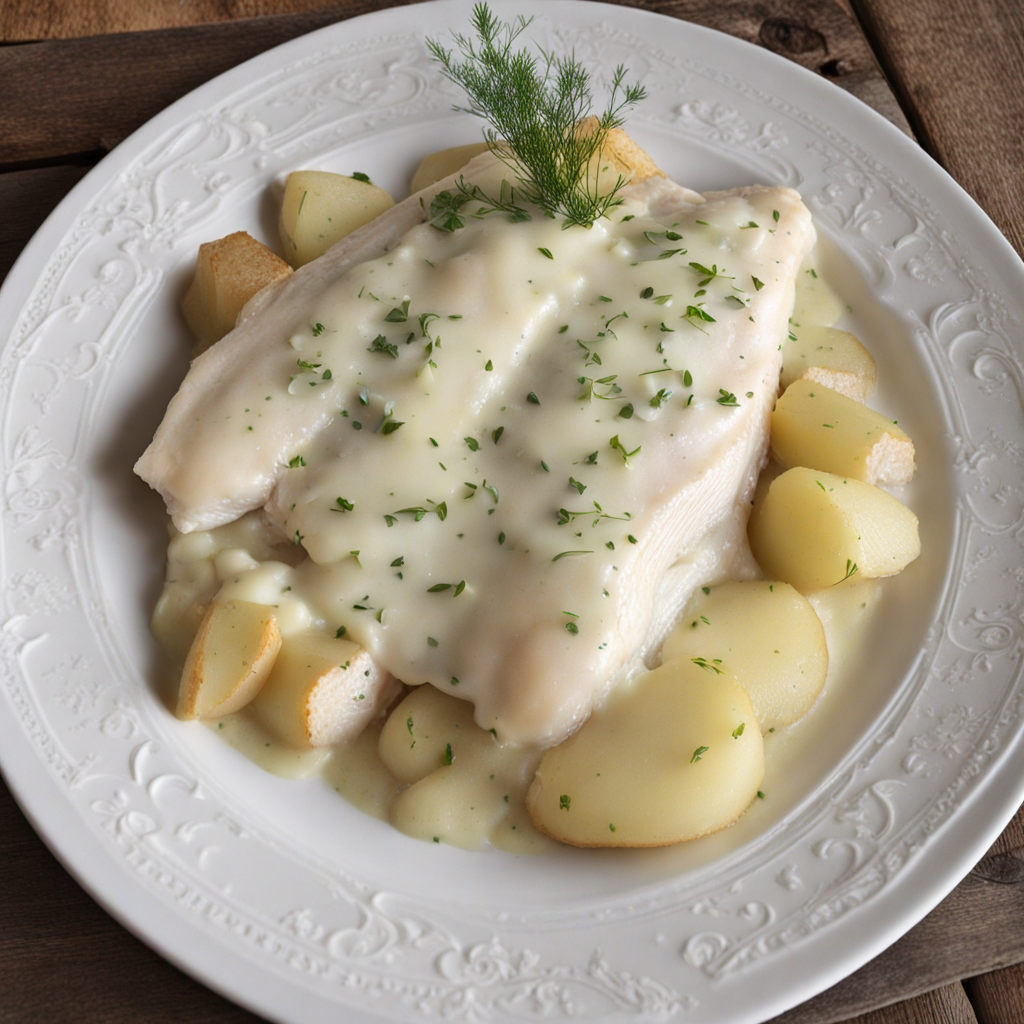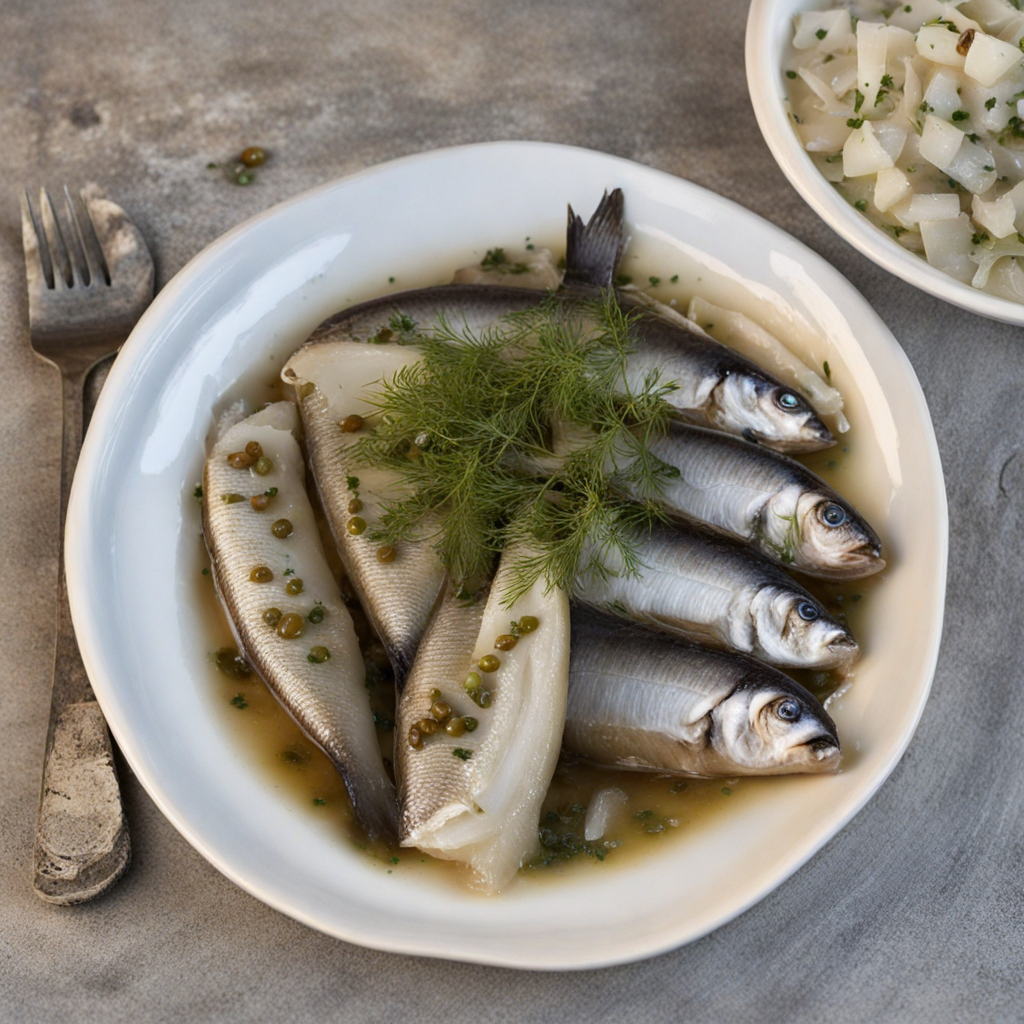Stegt Flæsk
Stegt Flæsk, often regarded as Denmark's national dish, is a tantalizingly crispy pork belly that embodies the rustic culinary heritage of the region. The dish features thick slices of pork belly that are expertly seasoned and pan-fried to achieve a golden-brown, crunchy exterior while maintaining a juicy, tender interior. The contrast in textures is one of the dish's most appealing aspects, making every bite a delightful experience. Traditionally, the pork is cooked until the fat renders down, allowing the meat to caramelize perfectly, creating a savory flavor that is both rich and satisfying. Accompanying the crispy pork is a generous serving of creamy, homemade parsley sauce, known as "persillesovs." This vibrant green sauce provides a fresh, herbal note that beautifully balances the richness of the pork. The dish is typically served with boiled potatoes, which absorb the flavors and add a comforting element to the meal. The combination of textures and flavors makes Stegt Flæsk a hearty and fulfilling dish that resonates deeply with Danish culture and traditions. Beyond its mouthwatering taste, Stegt Flæsk carries a sense of nostalgia and warmth, often enjoyed during family gatherings or special occasions. It reflects the simple yet delicious principles of Danish cooking, where quality ingredients shine through straightforward preparation. For anyone looking to explore a new culinary delight, indulging in Stegt Flæsk is a delicious way to experience the heart of Denmark's gastronomic identity.
How It Became This Dish
Stegt Flæsk: A Culinary Journey Through Danish History #### Origins of Stegt Flæsk Stegt Flæsk, a dish that translates to "fried pork belly," is often hailed as Denmark’s national dish, embodying both the rustic roots of Danish cuisine and the hearty flavors that characterize Scandinavian cooking. The origins of Stegt Flæsk can be traced back to the agrarian societies of Denmark, where pork was a staple protein due to the prevalence of pig farming. As early as the Middle Ages, pigs were a crucial part of Danish agriculture, and their meat was not only a primary source of sustenance but also a vital commodity for trade. In a predominantly agricultural society, the methods of preserving and preparing pork were essential. Traditional techniques such as curing, smoking, and frying became commonplace, primarily due to the need to make food last through long winters. Stegt Flæsk emerged as a practical dish, utilizing the fatty, flavorful cuts of pork belly, which were less expensive compared to leaner meats. The dish was typically prepared in a simple manner: thick slices of pork belly were fried until crispy, rendering out the fat and creating a crunchy exterior that complemented the rich, tender meat within. #### Cultural Significance In Denmark, Stegt Flæsk is much more than just a meal; it represents a connection to the land, traditions, and communal eating. The dish is often served with boiled potatoes and a creamy parsley sauce, known as "persillesovs," which adds a fresh, herbal contrast to the richness of the pork. This combination has become a classic, cherished by families across the country. Stegt Flæsk holds a place of honor in Danish culinary tradition, often featured in family gatherings and festive occasions. It is a dish that evokes nostalgia, reminiscent of home-cooked meals and the warmth of Danish hospitality. In fact, it is so beloved that it has been celebrated in various food festivals and events throughout Denmark, reinforcing its status as a symbol of national pride. The dish’s cultural significance extends beyond mere sustenance; it reflects the resilience and resourcefulness of the Danish people. Throughout history, Denmark has faced numerous challenges, including wars, economic hardships, and harsh winters. The ability to prepare hearty dishes like Stegt Flæsk from readily available ingredients exemplifies the Danish spirit of making the most of what one has, a theme that resonates deeply within Danish culture. #### Development Over Time As Denmark entered the modern era, the preparation and presentation of Stegt Flæsk began to evolve. In the 19th century, as urbanization increased and a shift towards industrialization occurred, culinary practices began to change. The rise of the middle class led to a greater emphasis on refined cooking techniques and the influence of European culinary trends. While Stegt Flæsk remained a staple, it started to be served in more sophisticated ways, often accompanied by elaborate sauces and sides. The post-World War II era saw a resurgence of interest in traditional Danish foods, including Stegt Flæsk. Amidst the backdrop of globalization and the increasing availability of international cuisines, many Danes began to seek comfort in their culinary heritage. The dish was embraced as a symbol of national identity, particularly during a time when the country was redefining itself in the wake of war and economic reconstruction. The latter half of the 20th century brought about a renewed focus on local and sustainable ingredients, further enhancing the popularity of Stegt Flæsk. As farm-to-table movements gained traction, chefs and home cooks alike began to prioritize locally sourced pork and organic potatoes. This shift not only improved the quality of the dish but also created a stronger connection between the food and the land. In recent years, Stegt Flæsk has experienced a renaissance among younger generations, who are eager to explore traditional dishes while incorporating contemporary culinary techniques. Modern interpretations often include variations on the classic recipe, such as the addition of spices or creative garnishes. Food bloggers and social media influencers have played a significant role in popularizing the dish, showcasing its appeal to a global audience. #### Stegt Flæsk Today Today, Stegt Flæsk is celebrated not only in Denmark but also in international food circles. Restaurants specializing in traditional Danish cuisine often feature the dish prominently on their menus, and it is a must-try for tourists seeking an authentic culinary experience. The dish's rich flavor and satisfying texture continue to resonate with diners, ensuring that it remains a beloved favorite. Moreover, Stegt Flæsk has transcended its humble origins, becoming a culinary ambassador for Denmark. It is often included in food festivals, cultural exhibitions, and even as a featured dish in international gastronomy events. The dish's representation of Danish culture and history has made it a focal point in discussions about national identity and heritage. In terms of preparation, while the classic recipe remains unchanged, the emphasis on quality ingredients has never been greater. Chefs are now more likely to source their pork from local farmers who prioritize animal welfare and sustainable practices. The dish is prepared with a focus on technique, ensuring that the pork belly is perfectly rendered for that ideal balance of crispiness and tenderness. #### Conclusion Stegt Flæsk is more than just a dish; it is a testament to the rich agricultural history of Denmark, the cultural significance of communal eating, and the enduring love for traditional foods. From its rustic beginnings to its contemporary interpretations, Stegt Flæsk has not only survived the test of time but has thrived, becoming an integral part of Denmark’s culinary identity. As Danes continue to celebrate their heritage through food, Stegt Flæsk stands as a delicious reminder of the past, present, and future of Danish cuisine. Whether enjoyed at a family gathering, a festive occasion, or a trendy restaurant, Stegt Flæsk remains a beloved symbol of national pride and culinary excellence.
You may like
Discover local flavors from Denmark







